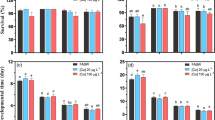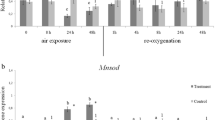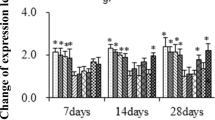Abstract
We measured the generation of intracellular reactive oxygen species (ROS) and the enzymatic activity and expression of glutathione-S transferase (GST) in response to temperature changes in the temperate copepod Tigriopus japonicus and the Antarctic copepod Tigriopus kingsejongensis. The levels of ROS and GST enzymatic activity were slightly elevated (P < 0.05) in T. japonicus in response to temperature changes but not in T. kingsejongensis. Furthermore, transcriptional regulation of all the GST genes in T. japonicus was significantly downregulated (P < 0.05) in response to temperature elevation to 35 °C, whereas messenger RNA expression of GST genes in T. kingsejongensis showed a significant increase (P < 0.05) at 24 °C, indicating that these two related but geographically distinct Tigriopus species have different molecular responses to temperature elevation. Overall, these findings indicate that temperature changes modulate oxidative damage through different modes of action, leading to different types of antioxidant defense in two congeneric copepods.
Similar content being viewed by others
References
Amado LL, Monserrat JM (2010) Oxidative stress generation by microcystins in aquatic animals: why and how. Environ Int 36:226–235
Binelli A, Parolini M, Pedriali M, Provini A (2011) Antioxidant activity in the zebra mussel (Dressena polymorpha) in response to triclosan exposure. Water Air Soil Pollut 217:421–430
Bradford MM (1976) A rapid and sensitive method for the quantitation of micro-gram quantities of protein utilizing the principle of protein-dye binding. Anal Biochem 7:248–254
Cailleaud K, Maillet G, Budzinski H, Souissi S, Forget-Leray J (2007) Effects of salinity and temperature on the expression of enzymatic biomarkers in Eurytemora affinis (Calanoida, Copepoda). Comp Biochem Physiol A 147:841–849
Campbell RG, Wagner MM, Teegarden GJ, Boudreau CA, Durbin EG (2001) Growth and development of the copepod Calanus finmarchicus reared in the laboratory. Mar Ecol Prog Ser 221:161–183
Dadras H, Dzyuba V, Cosson J, Golpour A, Dzyuba B (2016) The in vitro effect of temperature on motility and antioxidant response of common carp Cyprinus carpio spermatozoa. J Therm Biol 59:64–68
Devreker D, Souissi S, Seuront L (2004) Development and mortality of the first naupliar stages of Eurytemora affinis (Copepoda, Calanoida) under different conditions of salinity and temperature. J Exp Mar Biol Ecol 303:31–46
Gniadecki R, Thorn T, Vicanova J, Petersen A, Wulf HC (2000) Role of mitochondria in ultraviolet-induced oxidative stress. J Cell Biochem 80:216–222
Han J, Won E-J, Hwang D-S, Rhee J-S, Kim I-C, Lee J-S (2013) Effects of copper exposure on GST activity and on the expression of four GSTs under oxidative stress condition in the monogonont rotifer, Brachionus koreanus. Comp Biochem Physiol C 158:91–100
Han J, Won E-J, Lee B-Y, Hwang U-K, Kim I-C, Yim JH, Leung KMY, Lee YS, Lee J-S (2014) Gamma rays induce DNA damage and oxidative stress associated with impaired growth and reproduction in the copepod Tigriopus japonicus. Aquat Toxicol 152:264–272
Han J, Puthumana J, Lee M-C, Kim S, Lee J-S (2016) Different susceptibilities of the Antarctic and temperate copepods Tigriopus kingsejongensis and Tigriopus japonicus to ultraviolet (UV) radiation. Mar Ecol Prog Ser 561:99–107
Han J, Lee M-C, Kim S, Puthumana J, Kim I-C, Kim S, Lee J-S (2017) Adverse effects of water accommodated fractions (WAFs) of crude oil on the Antarctic copepod Tigriopus kingsejongensis and the temperate congeneric copepod T. japonicus and identification of 30 cytochrome P450 genes in T. kingsejongensis. Ecotoxicol Environ Saf 145:511–517
Hansen BW, Drillet G, Kozmér A, Madsen KV, Pedersen MF, Sørensen TF (2010) Temperature effects on copepod egg hatching: does acclimatization matter? J Plankton Res 32:305–315
Hoegh-Guldberg O, Bruno JF (2010) The impact of climate change on the world’s marine ecosystems. Science 328:1523–1528
Hwang D-S, Han J, Won E-J, Kim D-H, Jeong C-B, Hwang U-K, Zhou B, Choe J, Lee J-S (2016) BDE-47 causes developmental retardation with downregulated expression profiles of ecdysteroid signaling pathway-involved nuclear receptor (NR) genes in the copepod Tigriopus japonicus. Aquat Toxicol 177:285–294
IPCC (2007) Summary for policymakers. In: Parry ML, Canziani OF, Palutilof JP, van der Linden PJ, Hanson GE (eds) Climate change 2007: impacts, adaptation and vulnerability. Contribution of Working Group II to the Fourth Assessment Report of the Intergovernmental Panel on Climate Change. Cambridge University Press, Cambridge, pp 7–12
Jiménez-Melero R, Parra G, Guerrero F (2012) Effect of temperature, food and individual variability on the embryonic development time and fecundity of Arctodiaptomus salinus (Copepoda: Calanoida) from a shallow saline pond. Hydrobiologia 686:241–256
Jiménez-Melero R, Parra G, Souissi S, Guerrero F (2007) Post-embryonic developmental plasticity of Arctodiaptomus salinus (Copepoda: Calanoida) at different temperatures. J Plankton Res 29:553–567
Jung S-O, Lee Y-M, Park T-J, Park HG, Hagiwara A, Leung KMY, Dahms H-U, Lee W, Lee J-S (2006) The complete mitochondrial genome of the intertidal copepod Tigriopus sp. (Copepoda, Harpactidae) from Korea and phylogenetic considerations. J Exp Mar Biol Ecol 333:251–262
Kang S, Ahn D-H, Lee JH, Lee SG, Shin SC, Lee J, Min G-S, Lee H, Kim H-W, Kim S, Park H (2017) The genome of the Antarctic-endemic copepod, Tigriopus kingsejongensis. Gigascience 6:1–9
Kim B-M, Rhee J-S, Jeong C-B, Seo JS, Park GS, Lee Y-M, Lee J-S (2014) Heavy metals induce oxidative stress and trigger oxidative stress-mediated heat shock protein (hsp) modulation in the intertidal copepod Tigriopus japonicus. Comp Biochem Physiol C 166:65–74
Kim B-M, Lee JW, Seo JS, Shin K-H, Rhee J-S, Lee J-S (2015) Modulated expression and enzymatic activity of the monogonont rotifer Brachionus koreanus Cu/Zn and Mn-superoxide dismutase (SOD) in response to environmental biocides. Chemosphere 120:470–478
Kim H-S, Lee B-Y, Han J, Lee YH, Min G-S, Kim S, Lee J-S (2016) De novo assembly and annotation of the Antarctic copepod (Tigriopus kingsejongensis) transcriptome. Mar Genom 28:37–39
Koch J, Bui TT, Lundström Belleza E, Brinkmann M, Hollert H, Breitholtz M (2017) Temperature and food quantity effects on the harpacticoid copepod Nitocra spinipes: Combining in vivo bioassays with population modeling. PLoS One 23:e0174384
Lee H-W, Ban S, Ikeda T, Matsuishi T (2003) Effect of temperature on development, growth and reproduction in the marine copepod Pseudocalanus newmani at a satiating food concentration. J Plank Res 25:261–271
Lee J-S, Rhee J-S, Kim R-O, Hwang D-S, Han J, Choi B-S, Park GS, Kim I-C, Park HG, Lee Y-M (2010) The copepod Tigriopus japonicus genomic DNA information (574 Mb) and molecular anatomy. Mar Environ Res 69:S21–S23
Lee SR, Lee JH, Kim AR, Kim S, Park H, Baek HJ, Kim H-W (2016) Three cDNAs encoding vitellogenin homologs from Antarctic copepod, Tigriopus kingsejongensis: cloning and transcriptional analysis in different maturation stages, temperatures, and putative reproductive hormones. Comp Biochem Physiol B 192:38–48
Lee S-H, Lee M-C, Puthumana J, Park JC, Kang S, Han J, Shin K-H, Park HG, Om A-S, Lee J-S (2017a) Effects of temperature on growth and fatty acid synthesis in the cyclopoid copepod (Paracyclopina nana). Fish Sci 83:725–734
Lee Y-H, Kang H-M, Kim D-H, Wang M, Jeong C-B, Lee J-S (2017b) Adverse effects of methylmercury (MeHg) on life parameters, antioxidant systems, and MAPK signaling pathways in the copepod Tigriopus japonicus. Aquat Toxicol 184:133–141
Lesser MP (2006) Oxidative stress in marine environments: biochemistry and physiological ecology. Annu Rev Physiol 68:253–278
Livak KJ, Schmittgen TD (2001) Analysis of relative gene expression data using real time quantitative PCR and the 2−∆∆CT method. Methods 25:402–408
Mora C, Ospina A (2001) Tolerance to high temperatures and potential impact of sea warming on reef fishes of Gorgona Island (Tropical Eastern Pacific). Mar Biol 139:765–769
Park E-O, Lee S, Cho M, Yoon SH, Lee Y, Lee W (2014) A new species of the genus Tigriopus (Copepoda: Harpacticoida: Harpacticidae) from Antarctica. Proc Biol Soc Wash 127:138–154
Raisuddin S, Kwok KWH, Leung KMY, Schlenk D, Lee J-S (2007) The copepod Tigriopus: a promising marine model organism for ecotoxicology and environmental genomics. Aquat Toxicol 83:161–173
Rhee J-S, Lee Y-M, Kim B-M, Leung KM, Kim I-C, Yim JH, Lee J-S (2015) β-naphthoflavone induces oxidative stress in the intertidal copepod, Tigriopus japonicus. Environ Toxicol 30:332–342
Rhyne AL, Ohs CL, Stenn E (2009) Effects of temperature on reproduction and survival of the calanoid copepod Pseudodiaptomus pelagicus. Aquaculture 292:53–59
Roméo M, Hoarau P, Garello G, Gnassia-Barelli M, Girard JP (2003) Mussel transplantation and biomarkers as useful tools for assessing water quality in the NW Mediterranean. Environ Pollut 122:369–378
Speers-Roesch B, Ballantyne JS (2005) Activities of antioxidant enzymes and cytochrome c oxidase in liver of Arctic and temperate teleosts. Comp Biochem Physiol A 140:487–494
Stara A, Machova J, Velisek J (2012) Effect of chronic exposure to simazine on oxidative stress and antioxidant response in common carp (Cyprinus carpio L.). Environ Toxicol Pharmacol 33:334–343
Stara A, Kristan J, Zuskova E, Velisek J (2013) Effect of chronic exposure to prometryne on oxidative stress and antioxidant response in common carp (Cyprinus carpio L.). Pest Biochem Physiol 105:18–23
Strussmann CA, Conover DO, Somoza GM, Miranda LA (2011) Implications of climate change for the reproductive capacity and survival of New World silversides (family Atherinopsidae). J Fish Biol 77:1818–1834
Tomanek L (2011) Environmental proteomics: changes in the proteome of marine organisms in response to environmental stress, pollutants, infection, symbiosis, and development. Annu Rev Mar Sci 3:373–399
van Dooremalen C, Ellers J (2010) A moderate change in temperature induces changes in fatty acid composition of storage and membrane lipids in a soil arthropod. J Insect Physiol 56:178–184
Vehmaa A, Hogfors H, Gorokhova E, Brutemark A, Holmborn T, Engström-Öst J (2013) Projected marine climate change: effects on copepod oxidative status and reproduction. Ecol Evol 3:4548–4557
Vinagre C, Madeira D, Mendonça V, Dias M, Roma J, Diniz MS (2014a) Effect of increasing temperature in the differential activity of oxidative stress biomarkers in various tissues of the Rock goby, Gobius paganellus. Mar Environ Res 97:10–14
Vinagre C, Madeira D, Mendonça V, Dias M, Roma J, Diniz MS (2014b) Effect of temperature in multiple biomarkers of oxidative stress in coastal shrimp. J Therm Biol 41:38–42
Walther G-R, Post E, Convey P, Menzel A, Parmesan C, Beebee TJC, Fromentin J-M, Hoegh-Guldberg O, Bairlein F (2002) Ecological responses to recent climate change. Nature 416:389–395
Williams TD, Jones MB (1999) Effects of temperature and food quantity on the reproduction of Tisbe battagliai (Copepoda: Harpacticoida). J Exp Mar Biol Ecol 236:273–290
Zhang Y, Yan H, Lu W, Li Y, Guo X, Xu B (2013) A novel omega-class glutathione S-transferase gene in Apis cerana cerana: molecular characterisation of GSTO2 and its protective effects in oxidative stress. Cell Stress Chaperones 18:503–516
Acknowledgements
This work was supported by a grant of the National Research Foundation (2017R1A2B4010155) funded to Jeonghoon Han and was supported by a grant of the Korea-Polar Ocean Development: K-POD (project no. PM15050) from the Ministry of Oceans and Fisheries, Korea funded to Jae-Seong Lee.
Author information
Authors and Affiliations
Corresponding author
Electronic supplementary material
Below is the link to the electronic supplementary material.
Rights and permissions
About this article
Cite this article
Han, J., Jeong, CB., Byeon, E. et al. Effects of temperature changes on the generation of reactive oxygen species and the expression and activity of glutathione-S transferases in two congeneric copepods Tigriopus japonicus and Tigriopus kingsejongensis. Fish Sci 84, 815–823 (2018). https://doi.org/10.1007/s12562-018-1224-3
Received:
Accepted:
Published:
Issue Date:
DOI: https://doi.org/10.1007/s12562-018-1224-3








